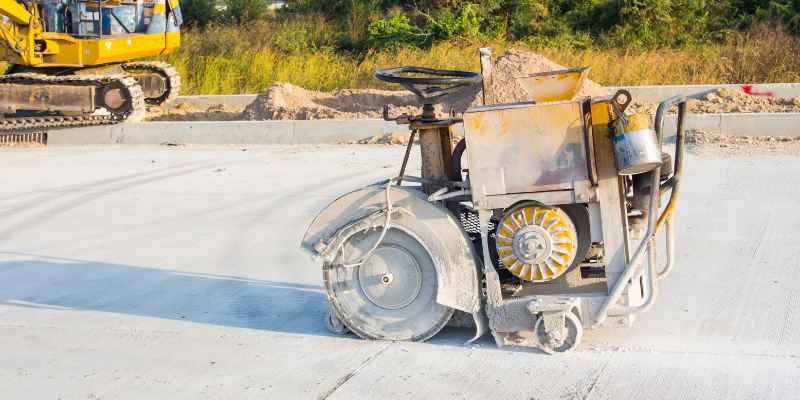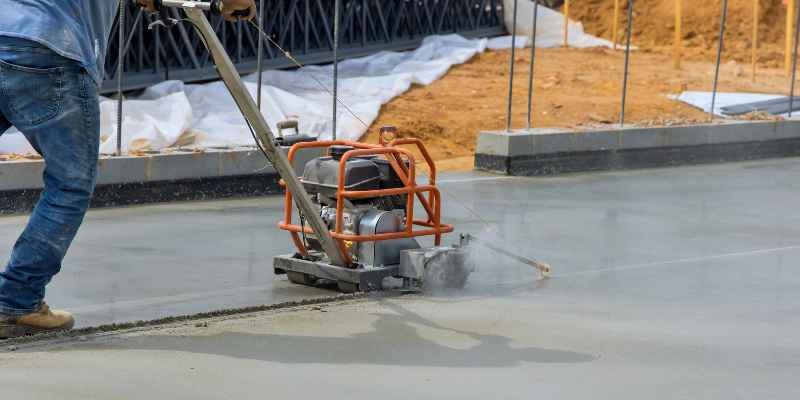Concrete saw cut joints are used to control cracking in concrete structures. These joints are carefully planned cuts made into the concrete slab to minimize random cracking.
By strategically placing saw cuts, the stress is relieved, reducing the chances of uncontrolled cracking. Concrete saw cut joints play a crucial role in maintaining the structural integrity and longevity of concrete pavements and floors. Properly executed saw cuts help to control the formation of cracks, ensuring the durability and stability of the concrete surface over time.
Implementing saw cut joints requires precision and expertise to achieve the desired results. We will explore the importance of concrete saw cut joints, their benefits, and best practices for implementing them in construction projects.

Importance Of Concrete Saw Cut Joints
Concrete saw cut joints are crucial in enhancing the structural integrity and durability of concrete surfaces. These joints play a significant role in preventing undesirable cracks that can compromise the stability of the structure.
Purpose Of Saw Cut Joints
- Divide large concrete areas into manageable sections.
- Control cracking caused by shrinkage or expansion.
- Allow for movement without damaging the concrete.
Benefits Of Proper Jointing
- Extend the lifespan of the concrete surface.
- Improve overall aesthetics and functionality.
- Prevent issues such as spalling and heaving.
By incorporating well-planned saw cut joints in your concrete projects, you can ensure a longer-lasting and visually appealing finish that is resistant to common structural troubles.
Factors Affecting Saw Cut Joint Performance
Saw cut joint performance in concrete can be affected by various factors such as the type of saw blade, cutting speed, diamond blade quality, water usage, and joint spacing. These factors play a crucial role in ensuring the durability and functionality of saw cut joints in concrete structures.
Concrete saw cut joints play a crucial role in controlling cracks and ensuring the overall performance and durability of concrete structures. The effectiveness of these joints largely depends on various factors that need to be carefully considered. Here, we take a closer look at the main factors affecting saw cut joint performance.
Depth and Width of Joints
The depth and width of saw cut joints are fundamental considerations in achieving optimal performance. The depth of the joint should typically be at least one-quarter of the slab thickness to be effective. Moreover, the width of the joint should be proportional to the slab thickness, generally ranging from one-quarter to one-third of the slab thickness.
Spacing and Layout Considerations
The spacing and layout of saw cut joints are vital to the overall performance of concrete structures. Proper spacing between joints is crucial, with the commonly recommended range being 24 to 36 times the thickness of the slab. Additionally, the layout of joints should account for the specific loads and stresses the concrete structure will be subjected to, as well as environmental conditions.
In conclusion, the performance of saw cut joints in concrete structures is influenced by various factors such as the depth and width of joints, as well as spacing and layout considerations. Adhering to these factors is essential in ensuring the effectiveness of saw cut joints in controlling cracking and preserving the integrity of concrete structures.
Types Of Concrete Saw Cut Joints
Discover the various types of concrete saw cut joints, including control joints, construction joints, and expansion joints. These joints help reduce cracking and ensure the durability of concrete structures. Learn how different saw cut joints play a crucial role in maintaining the integrity of concrete surfaces.
Control Joints
Control joints are strategically placed saw cuts in concrete slabs to help control cracking due to shrinkage. These joints divide the concrete into manageable sections that allow for controlled cracking along predefined lines. Preventing random cracking and promoting overall structural integrity.
Benefits of control joints:
– Limits cracking: Prevents unsightly and damaging cracks in concrete.
– Improves aesthetics: Enhances the appearance of concrete surfaces with clean, controlled lines.
– Reduces maintenance: Minimizes the need for costly repairs over time.
Expansion Joints
Expansion joints accommodate concrete slab expansion caused by temperature changes and moisture variations. These joints provide the necessary space for the concrete to expand and contract without causing damage or deformation to the structure. Critical for ensuring long-term durability in concrete construction projects.
Advantages of expansion joints:
– Prevents buckling: Allows concrete to expand naturally without pushing against adjacent structures.
– Enhances longevity: Protects concrete from structural damage due to expansion and contraction forces.
– Ensures stability: Maintains the stability of concrete slabs over time.
Construction Joints
Construction joints are intentional breaks in concrete pouring to allow for phased construction. These joints are created to separate different phases of concrete placement, ensuring a seamless transition between sections. Essential for maintaining structural integrity and quality in multi-stage construction projects.
Importance of construction joints:
– Facilitates phased construction: Enables construction in stages without compromising structural strength.
– Improves efficiency: Streamlines the concrete pouring process for large-scale projects.
– Enhances durability: Prevents structural weaknesses at junction points during construction.
Best Practices For Cutting Concrete Joints
When it comes to ensuring the durability and longevity of your concrete projects, proper cutting of joints is crucial. The process of cutting joints in concrete helps control cracking and allows for expansion and contraction. Let’s delve into the Best Practices for Cutting Concrete Joints to achieve optimal results.
Proper Timing Of Cutting
Timing of cutting joints in concrete is essential to their effectiveness. It’s ideal to cut joints as soon as the concrete is firm enough to prevent raveling but before uncontrolled cracking occurs.
Choosing The Right Saw Equipment
Selecting the appropriate saw equipment is paramount for precise joint cutting. Ensure you use a high-quality diamond blade that is suitable for the specific concrete mix and reinforcement used in your project.
Joint Sealing And Maintenance
When it comes to concrete saw cut joints, joint sealing and maintenance play a crucial role in ensuring the durability and longevity of your concrete structures. Properly sealing and maintaining the joints can prevent water infiltration, control cracking, and preserve the structural integrity of the concrete.
Importance Of Sealants
Sealants are a vital component in joint sealing and maintenance. They are designed to create a protective barrier that prevents water and other substances from seeping into the joints. By sealing the joints, sealants help to minimize the risk of damage caused by water infiltration, such as freeze-thaw cycles and corrosion.
Moreover, sealants also help to control cracking in the concrete. Concrete expands and contracts due to temperature changes, and saw cut joints provide space for the concrete to move without causing cracking. By applying sealants to the joints, you can promote controlled cracking along the predetermined saw cut lines, preventing unsightly and potentially harmful random cracking.
Regular Inspection And Repair
Regular inspection and repair are essential to maintain the effectiveness of joint sealants. Over time, sealants may deteriorate due to exposure to UV rays, extreme weather conditions, or heavy traffic. Cracks, gaps, or signs of wear and tear should be promptly addressed to prevent further damage.
To ensure the longevity of the sealants, regular inspections should be conducted to identify any issues. This includes checking for cracks, gaps, or adhesive failure. Once identified, repairs should be carried out immediately using suitable sealants and patching materials.
It is important to note that different sealants may have different lifespans and maintenance requirements. Some sealants may require reapplication every few years, while others may last longer. Consulting with a professional and following manufacturer’s guidelines can help ensure the sealants are maintained properly.
Common Mistakes To Avoid
When it comes to concrete saw cut joints, it’s crucial to be aware of common mistakes that can impact the overall quality and longevity of the concrete. By understanding these mistakes, you can ensure that your concrete work is not only functional but also durable. Let’s take a look at some of the common mistakes to avoid when dealing with concrete saw cut joints.
Improper Joint Spacing
Improper joint spacing is a common mistake that can lead to cracking and structural issues in concrete. Inadequate spacing between saw cut joints can result in uncontrolled cracking due to shrinkage or temperature changes. On the other hand, excessive spacing can lead to random cracks forming outside of the cut lines, impacting the aesthetics and integrity of the concrete. It’s essential to follow recommended guidelines for joint spacing to ensure the structural integrity of the concrete.
Neglecting Joint Sealing
Neglecting joint sealing is another critical mistake when it comes to concrete saw cut joints. Failure to seal joints can lead to moisture infiltration, which can cause erosion, corrosion of reinforcement, and overall degradation of the concrete. Proper joint sealing helps prevent these issues and extends the lifespan of the concrete. It’s important to prioritize joint sealing as an essential step in the concrete saw cutting process.
Innovations In Concrete Jointing
When it comes to concrete construction, one important aspect that cannot be overlooked is jointing. Concrete saw cut joints provide vital lines of defense that prevent cracks and allow for the natural expansion and contraction of the material. Traditionally, joint cutting involved creating straight lines with specialized tools after the concrete had set. However, with advancements in technology and materials, new innovations in concrete jointing have emerged.
New Technologies For Joint Cutting
In recent years, the construction industry has witnessed the introduction of cutting-edge technologies that have revolutionized the way concrete saw cut joints are created. These innovative technologies offer a higher level of precision and efficiency, ensuring optimum joint performance. Some of the notable advancements include:
- Laser-Guided Joint Cutting: This state-of-the-art technology utilizes lasers to guide the cutting process, resulting in perfectly straight and accurate joints. The laser guidance system ensures that the cuts are made with utmost precision, reducing the chances of errors and inconsistencies.
- Computer-Controlled Joint Cutting: With the help of computer-controlled systems, joint cutting can now be executed with even greater precision. These systems allow for automated cutting based on pre-programmed specifications, eliminating human error and ensuring consistently accurate joints.
- Diamond Blade Technology: Diamond blades have become an industry standard due to their exceptional cutting performance. These blades are made with industrial-grade diamonds that can cut through concrete with ease, resulting in clean, smooth joints. The increased durability of diamond blades also means a longer lifespan, reducing costs in the long run.
Alternative Materials For Joint Filling
In addition to advancements in joint cutting technologies, there have also been significant developments in the materials used for joint filling. While traditional materials like standard concrete or asphalt have been widely used, alternative materials are gaining popularity for their enhanced performance and longevity. Some notable alternatives include:
- Polyurea: Polyurea joint fillers offer excellent flexibility and durability. They have a rapid curing time, allowing for quick installation and reducing downtime. Additionally, polyurea fillers exhibit superior resistance to chemicals, abrasion, and temperature extremes, making them perfect for demanding environments.
- Epoxy Resin: Epoxy resin joint fillers are known for their exceptional bond strength and long-lasting performance. They provide a seamless and smooth surface, enhancing the overall appearance of the joint. Epoxy resin fillers are also resistant to chemicals and can withstand heavy traffic, ensuring longevity and reduced maintenance.
- Polymeric Sands: Polymeric sands are a popular choice for joint filling in outdoor applications. These sands consist of a mixture of quartz and polymer, which creates a solid and flexible barrier. Polymeric sands offer excellent resistance to water penetration, preventing weed growth and reducing the risk of joint erosion.
With these innovative technologies and alternative materials, concrete jointing has evolved significantly. Contractors now have access to advanced tools and materials that allow for more precise and durable joint creation, ensuring the longevity and structural integrity of concrete structures.
Conclusion And Future Trends
Summary Of Key Points
Concrete saw cut joints play a crucial role in controlling cracking and ensuring the longevity of concrete structures. Proper planning and execution of these joints are essential for enhancing the performance and durability of concrete.
Emerging Practices In Joint Optimization
When it comes to concrete saw cut joints, emerging practices are focused on optimizing joint spacing and depth. By utilizing advanced techniques and technologies, such as laser-guided saws and robotic equipment, contractors can achieve precise and efficient joint patterns that minimize cracking and improve structural integrity. Additionally, the use of high-performance concrete mixes and additives is gaining traction to further enhance the durability and resistance of concrete saw cut joints.

Frequently Asked Questions For Concrete Saw Cut Joints
What Are Concrete Saw Cut Joints?
Concrete saw cut joints are intentional incisions made in concrete to control cracks caused by shrinkage and temperature changes. These joints help in maintaining structural integrity and minimizing the risk of random cracking in concrete surfaces. They are typically formed using saws equipped with diamond blades.
Why Are Saw Cut Joints Necessary In Concrete?
Saw cut joints are vital in concrete to prevent uncontrolled shrinkage cracks and ensure structural stability. By creating these intentional incisions, the natural cracking of concrete is guided along these lines, reducing the likelihood of unsightly and potentially damaging cracks that could compromise the integrity of the surface.
When Should Concrete Saw Cut Joints Be Made?
Concrete saw cut joints should be made at the right time, typically within 6-18 hours after the concrete has been poured or when the concrete has achieved the desired level of hardness. Proper timing ensures clean and effective joint creation, preventing unintended cracks and preserving the structural quality of the concrete.
How Deep Should The Saw Cuts Be In Concrete Joints?
The depth of saw cuts in concrete joints is determined by the thickness of the concrete slab. Generally, the depth should be one-fourth of the concrete’s thickness. This depth provides an effective guide for cracks and allows for the optimal control of cracking while maintaining the structural integrity of the concrete surface.
Conclusion
Concrete saw cut joints are an essential element in concrete construction, ensuring durability and minimizing cracks. By carefully planning and executing saw cuts, you can control and direct concrete cracking. These joints not only enhance the aesthetics but also enhance the performance and longevity of the concrete structure.
It is crucial to consult professionals for accurate joint spacing and proper cutting techniques to achieve optimum results. Understand the importance of saw cut joints and utilize them correctly to ensure a strong and resilient concrete structure. Let your construction project stand the test of time.


